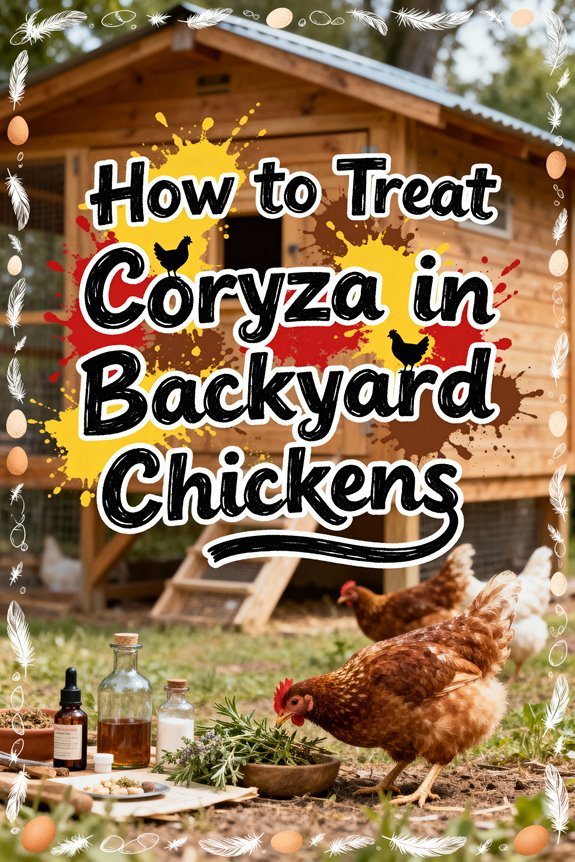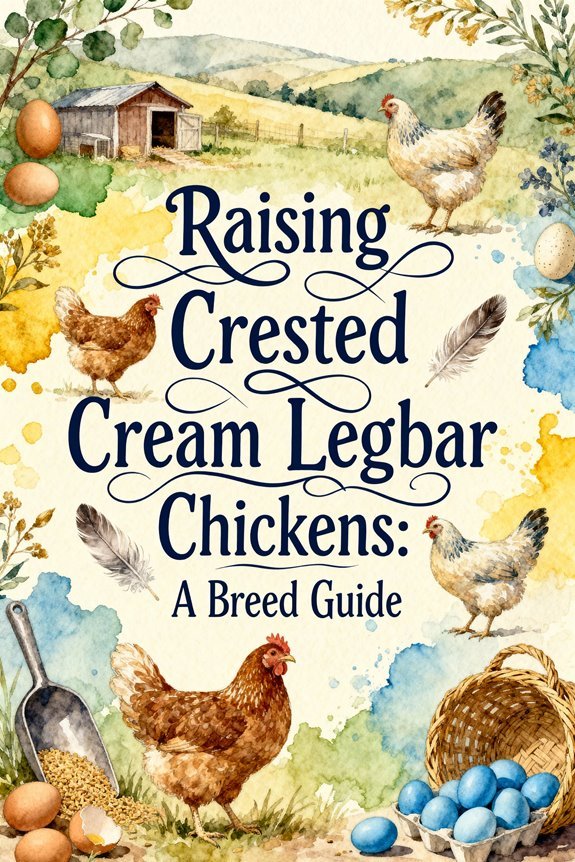How to Treat Coryza in Backyard Chickens
To treat coryza in your backyard chickens, you’ll need to immediately isolate infected birds and implement antibiotic therapy, typically using tetracyclines or erythromycin under veterinary guidance. Establish a quarantine area with ideal ventilation, maintain strict biosecurity protocols, and provide supportive care through electrolyte-enhanced hydration and energy-dense nutrition. Monitor respiratory symptoms and egg production for 10-14 days while maintaining thorough coop disinfection. Understanding the complete treatment protocol guarantees the highest recovery success rates.
Recognizing Early Signs of Coryza
How can poultry keepers identify Coryza before it spreads through their entire flock? The initial presentation typically manifests as unilateral facial swelling, accompanied by serous discharge from the nares and conjunctival irritation. You’ll notice affected birds displaying characteristic early symptoms including ocular crusting and a distinctive malodorous nasal exudate.
Monitor your flock for birds exhibiting respiratory distress, characterized by gurgling or raspy breathing patterns. Pay particular attention to individuals that isolate themselves from the group or show marked lethargy, as these behavioral changes often precede severe clinical manifestations. A sudden decline in egg production rates serves as a critical diagnostic indicator. Early detection through daily observation of these primary symptoms is essential for implementing timely intervention protocols and preventing widespread flock infection. Infected birds can become lifelong carriers of the disease even after recovery.
Essential Steps for Immediate Isolation
When infectious coryza is suspected in your flock, establishing immediate quarantine protocols becomes paramount for disease containment. You’ll need to implement robust isolation strategies by relocating infected birds to a separate enclosure equipped with dedicated feeders, waterers, and bedding materials. Since symptoms typically manifest within 24-72 hours after exposure, quick action is essential. Ascertain your quarantine space maintains proper ventilation while preventing contact with healthy birds or potential vectors.
Your quarantine duration must extend for a minimum of 21 days, with consistent monitoring of symptom progression. During this period, you’ll need to wear designated protective clothing and utilize veterinary-grade disinfectants when managing the isolation area. Maintain stringent environmental controls by keeping the quarantine space dry and clean, while providing balanced nutrition and probiotic supplements to support recovery. Document all observations to determine when birds can safely return to the main flock.
Medical Treatment Options and Antibiotics
Once you’ve established proper isolation protocols, addressing the bacterial infection through targeted antibiotic therapy becomes the next clinical priority. Several antibiotic choices are effective against Avibacterium paragallinarum, including tetracyclines, erythromycin, and fluoroquinolones like enrofloxacin. The disease typically shows a high morbidity rate but death losses remain relatively low in uncomplicated cases.
For non-laying hens, enrofloxacin can be administered at 50 mg/L in drinking water, while sulfadimethoxine requires an initial dose of 330-400 mg/L, followed by reduced dosage guidelines over 4-5 days. However, if you’re treating laying hens, you’ll need to take into account strict withdrawal periods to prevent egg contamination. You should combine antibiotic treatment with supportive care, including probiotics and electrolytes. Remember that while antibiotics alleviate symptoms, they won’t eliminate carrier status, making veterinary consultation essential for best treatment outcomes.
Creating a Recovery Environment
To establish a perfect recovery environment for chickens infected with Avibacterium paragallinarum, implementing rigorous environmental controls becomes paramount. You’ll need to maintain strict sanitation protocols while managing environmental stressors that could compromise your recovering chickens’ immune responses.
Begin by isolating infected birds in a dedicated quarantine area with ideal ventilation and humidity control. Install proper air circulation systems while avoiding direct drafts on your flock. Since infected birds can carry the pathogen indefinitely, creating a permanent isolation area may be necessary. Implement daily cleaning protocols, including immediate removal of soiled bedding and thorough disinfection of all surfaces and equipment. For effective stress management, ascertain adequate space per bird, maintain consistent temperatures, and minimize disruptions to flock dynamics. You’ll also need to establish extensive biosecurity measures, including boot baths, dedicated equipment for quarantined birds, and protocols to exclude potential disease vectors like wild birds and rodents.
Nutrition and Hydration Support
During the acute phase of infectious coryza, implementing an extensive nutrition and hydration protocol becomes crucial for supporting immunological function and accelerating recovery. You’ll need to focus on nutrient sources that are easily digestible and energy-dense, including cooked oatmeal, scrambled eggs, and mashed vegetables rich in vitamins A, C, and E. Conditions can deteriorate quickly with a mortality rate of 20-50%, making immediate nutritional intervention essential. While some owners may consider pickles as treats, they can cause salt toxicity and should be avoided during illness. Consider offering a layer feed blend that includes essential amino acids for immune support and recovery.
For hydration strategies, provide constant access to fresh water and consider supplementing with electrolyte solutions. You can create a homemade electrolyte mix or use commercial products to restore mineral balance. Adding apple cider vinegar to drinking water (2 ml per 2 liters) may help reduce mucus accumulation and boost immunity. Monitor your birds’ fluid intake closely, as proper hydration greatly impacts respiratory symptom severity and recovery time. Complement these measures with probiotic-rich foods like yogurt to support gut health.
Preventing Spread Within Your Flock
Preventing infectious coryza transmission within your flock requires implementing thorough biosecurity protocols and environmental controls. Monitor bird behavior daily for early symptoms like facial swelling and respiratory distress, immediately isolating affected individuals to reduce aerosol spread. Maintain strict quarantine protocols of 10-21 days for new birds before integration. Antibiotic treatment may be necessary under veterinary guidance.
Environmental factors play an essential role in pathogen control. Install proper ventilation systems to minimize airborne bacterial concentrations while managing humidity levels. Disinfect coops, feeders, and waterers weekly using veterinary-approved products like “Coop Clean.” Remove organic matter promptly to prevent bacterial proliferation in damp conditions. Implement physical barriers against wild birds and maintain separate equipment for quarantined birds. Change clothing and disinfect footwear between handling different groups to prevent mechanical disease transfer.
Post-Recovery Care and Monitoring
After chickens recover from infectious coryza, implementing a thorough post-recovery monitoring protocol remains essential for preventing disease recurrence and managing carrier status. You’ll need to conduct systematic symptom tracking, observing respiratory signs, appetite levels, and overall health for 10-14 days minimum.
Ensure completion of prescribed antibiotic follow-up regimens to prevent bacterial resistance and relapse. Monitor egg production patterns, as hens may experience temporary reproductive regression. The use of approved antibiotics like erythromycin has shown effectiveness in preventing reinfection when properly administered. Maintain environmental controls with ideal temperature and ventilation while providing nutrient-dense feed supplementation to support immune recovery.
Since recovered birds often become lifelong Avibacterium paragallinarum carriers, implement strict biosecurity measures and consider quarantine protocols. Document all health observations and treatment responses to inform long-term management strategies and early intervention if symptoms recur.
Effective Cleaning and Disinfection
Proper sanitation protocols are fundamental to controlling infectious coryza and preventing its spread within poultry populations. You’ll need to implement systematic disinfection techniques, beginning with thorough dry cleaning to remove organic matter and debris. Start by evacuating the coop and eliminating all visible contamination through scraping and sweeping.
Follow with extensive wet cleaning using detergent solutions, paying particular attention to corners and crevices where pathogens persist. Once surfaces are clean, apply appropriate disinfectants at recommended concentrations, guaranteeing adequate contact time. For maximum effectiveness, apply disinfectants at one gallon per 150-200 square feet of surface area. Establish regular cleaning schedules that include daily manure removal and weekly deep cleaning of feeders and waterers. Maintain proper ventilation and monitor humidity levels to minimize environmental conditions conducive to bacterial growth. Document all sanitation procedures to guarantee consistent protocol adherence.
Vaccination Strategies for Future Prevention
Effective vaccination protocols represent a critical component in preventing infectious coryza outbreaks, though they require careful consideration for backyard flocks. You’ll need to understand that vaccine types primarily consist of inactivated bacterins, as live vaccines aren’t recommended for non-commercial settings due to transmission risks.
For ideal protection, you’ll need to match vaccines to local Avibacterium paragallinarum serotypes. The standard protocol involves administering initial doses at 6-8 weeks of age, followed by a second dose before egg laying begins. Revaccination frequency typically occurs twice yearly in previously infected flocks. Similar to Newcastle disease vaccine, coryza vaccines are more commonly used in commercial settings than backyard flocks.
Be aware that vaccination in backyard settings requires state veterinary approval and should integrate with extensive biosecurity measures. You’ll achieve better outcomes when combining vaccination with strict flock management protocols and regular health monitoring.
Ongoing Flock Health Management
To maintain a disease-resistant flock following coryza treatment, you’ll need to implement thorough health management protocols that address multiple vectors of infection. Monitor flock behavior daily for disease indicators such as lethargy, respiratory distress, or decreased feed consumption. Consider using natural pest control methods like diatomaceous earth in bedding and nesting areas to prevent parasite infestations.
Implement extensive biosecurity measures including quarantine protocols for new birds and strict access control to prevent wildlife-mediated pathogen transmission. You’ll need to maintain ideal environmental conditions through proper ventilation, ensuring ammonia levels remain below 25 ppm, and sustaining appropriate humidity levels between 40-60%. Institute a rigorous cleaning schedule using approved disinfectants on all equipment and housing surfaces. Additionally, provide age-appropriate nutrition through pelleted feeds that meet specific life-stage requirements, and maintain detailed health records to track potential disease patterns within your flock. Using dedicated clothing and footwear when entering the coop area helps minimize cross-contamination risks between different areas of your property.


